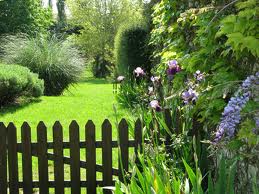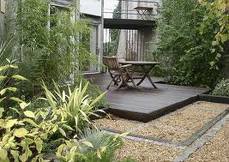





Although, given the choice, most of us would prefer a larger garden, it is surprising just what can be done with a tiny one. In a small garden you can achieve a neatness, a richness of flowers and grow incredible quantities of produce with the same labour that would be dissipated just cutting the grass in a large garden. Alternatively small gardens can be planned to be extremely undemanding once established. When only a small area is involved, any money spent is more effective. It can be used to buy more slow-growing evergreen shrubs or low-maintenance features such as paved areas, stonework, timber work and thick mulches.
 In a larger garden far more needs to be spent on machinery and maintenance. The best features in a small garden must be concentrated near the house, where they can be seen from the comfort of the windows; in a larger garden they are spread thinner and further afield. Small gardens predominate in denser urban areas rather than in open country, so they benefit from the additional shelter and warmth that these provide. All the brickwork, tiles and pavements act as heat stores, and the buildings reduce low-level wind. This protection is augmented by the heat from all the people, buildings and cars, and enhanced by their carbon dioxide. These factors can give the urban gardener a great advantage, extending the season for several weeks over that of the country dweller. The last frost of spring always comes much later in pretty little valleys than it does in the city nearby.
In a larger garden far more needs to be spent on machinery and maintenance. The best features in a small garden must be concentrated near the house, where they can be seen from the comfort of the windows; in a larger garden they are spread thinner and further afield. Small gardens predominate in denser urban areas rather than in open country, so they benefit from the additional shelter and warmth that these provide. All the brickwork, tiles and pavements act as heat stores, and the buildings reduce low-level wind. This protection is augmented by the heat from all the people, buildings and cars, and enhanced by their carbon dioxide. These factors can give the urban gardener a great advantage, extending the season for several weeks over that of the country dweller. The last frost of spring always comes much later in pretty little valleys than it does in the city nearby.
Small gardens have close neighbours which can mean a loss of privacy, or equally, companionable conversation and friendly rivalry. With larger gardens the privacy increases — very rapidly once you can afford space for an informal hedge or windbreak. The choice of what you can squeeze in becomes much greater, but of course time, labour and cash become spread more thinly.
One advantage for the organic gardener is the isolation that can come in a well-hedged garden. Spray drift, pests and disease spores are less likely to arrive on your plants the further away their sources are kept. Similarly, with space for more plants and habitats, more forms of beneficial wildlife can be encouraged and retained and intricate ecological webs can be built up, aiding pest control.
Large gardens also allow more robbing of Peter to pay Paul — you can, for instance, take prunings, grass clippings from lawns, paths and wild areas, and leaves from under trees to compost for use in the vegetable beds and elsewhere. With spare capacity the land can be less intensively cropped, which requires less labour to produce the same amount as from a small space and permits longer rotations with green manure leys to give better, cleaner crops more easily. In the larger garden, livestock can be converting wastes to eggs or meat and providing a source of high-value fertiliser, though there is no reason, bylaws allowing, why even the smallest garden should not have a chicken or two in an ark.
There are other benefits of scale for a larger garden. The bigger the task the more efficient machinery is, and the professional models work more effectively than small ones for home use. For example, it is much quicker (though noisier) to work with a hired petrol hedge trimmer than with a pair of shears or a small electric model.
Even the tiniest plot has room for herbs and many can be cajoled into pots and containers. With a patio area to sit on, scented plants around and water in some form, you can create a tranquil little retreat from the hurly burly of life. Fruit can be grown, in pots, trained on walls and as screens; there may also be room for a small salad or herb bed or an ornamental area with mostly productive plants. There is always room for a compost bin and for bees! Beekeeping is ideal for town gardeners because bees add life and interest, are very productive and thrive on the longer, milder seasons and myriad urban plants. They are more productive with increased attention, so are well suited to those with small gardens and more spare time. Nest boxes and food for birds and hedgehogs can also be squeezed into the tiniest plots.
 Small size does not so much prevent you from making any one sort of garden (except for those demanding forest trees!) as limit the number of internal subdivisions you can have. You cannot sensibly fit a fruit cage, a rose border, a vegetable plot, lawn and a water feature into a tiny plot.
Small size does not so much prevent you from making any one sort of garden (except for those demanding forest trees!) as limit the number of internal subdivisions you can have. You cannot sensibly fit a fruit cage, a rose border, a vegetable plot, lawn and a water feature into a tiny plot.
However, you could make a very beautiful or productive garden from one or even a couple of these. It is probably better to make over the whole plot in one theme rather than trying to incorporate every possible feature to make a miniature of a larger garden.
The allotment is usually small scale but has other problems, theft being the worst and regulations the second; the distance from home does not help. Sadly too often the best things to grow are those that are least easy to steal in a hurry, so gooseberries beat sweetcorn!
Larger gardens need careful planning and good routines, otherwise too many chores eat up the time. Larger suburban is perhaps the optimum size for casual gardeners as it can be kept extremely attractive and productive without stealing all your time or forcing you to hire help.
The typical garden for most people, the larger suburban plot has room for subdivision, though usually on a small scale. Often there’s a formal front garden, and maybe enough space at the back to produce significant amounts of fruit and vegetables — if it’s favourably situated and well planned. Concentrate on a few ‘bolt on’ areas rather than trying to squeeze them all in, then each can have sufficient space and attention to become worthwhile. For example, have a wee vineyard or some cider apple trees, but not both. Site the less attractive greenhouse and vegetable plot behind the fruitcage and away from the house, and surround your home with flowers, a patio and fresh herbs nearby for convenience.
Once you get up to an acre of ground, what and how you grow is limited mainly by time and money. The choice widens, but the garden will need rigorous planning and/or ruthless maintenance or hired labour. I have squeezed more and more into my small acre, but it does take up the equivalent of every weekend throughout the year to stay on top of it. This is the optimum size for a very keen gardener — any larger and it needs to be simplified in many areas or help acquired. Intensive methods are better replaced with extensive, such as half-standard trees in grassed orchard rather than trained cordons, and vegetables on the flat instead of raised beds with fewer, bigger, more shrubby borders with sweeping curves and less edging.
Grass cutting is effective for maintaining large areas neatly but is one of the most time-consuming chores and it may prove a good idea to hire labour for this rather than for the more enjoyable work. Ensuring ease of access, installing good pathways and putting the least visited areas furthest away are vitally important as much time can be wasted going back to fetch a tool half an acre away. The space available allows for a wide range of habitats and a garden this size can easily be made self-sufficient in fertility, becoming very rich in useful ecological systems with wildlife interest.
With several acres then almost any garden imaginable could be created but time, money and enthusiasm can become too stretched to maintain it. In order to keep the labour down, large areas need to be simplified, grassed and cut or trimmed regularly, but then can feed the rest of the garden with the clippings recycled as mulch and fertility. Machinery and hired labour become necessities for many more of the tasks, though four-legged lawnmowers can replace these to a great extent. Gardening as such becomes landscaping around the house. A very large garden then effectively becomes more like a larger suburban garden with a couple of acres of paddock or private woodland extending out from it. I think too much space may prove more of a curse than a blessing, but I’d love the chance to find out!
Copyright © www.100flowers.win Botanic Garden All Rights Reserved